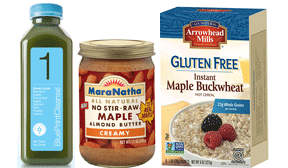 ition from private label players in the natural and organic space is keeping the Hain Celestial Group, Inc. on its toes, said Irwin Simon, president and chief executive officer. Wal-Mart’s recently announced partnership with Wild Oats to offer affordable organic items is good news and bad news for the Lake Success, N.Y.-based company.
ition from private label players in the natural and organic space is keeping the Hain Celestial Group, Inc. on its toes, said Irwin Simon, president and chief executive officer. Wal-Mart’s recently announced partnership with Wild Oats to offer affordable organic items is good news and bad news for the Lake Success, N.Y.-based company.“I think the positive here for Hain is … it’s showing that the consumer that’s shopping at Wal-Mart today wants organic products,” Mr. Simon said during a May 29 presentation at the Citi Global Consumer Conference in New York. “What they said is 94% of their consumers would buy organic product if it was available and affordable. That’s the big thing today for Hain, is making sure our products are affordable, making sure we are priced right.”
Threatening Hain’s market share is an improved quality and breadth of private label products in the United States, supported by strong innovation from such companies as TreeHouse Foods and Ralcorp Holdings, a subsidiary of ConAgra Foods, Mr. Simon said.
“Whether it’s Wild Oats, Whole Foods 365, whether it’s Trader Joe’s, what it forces Hain to make sure we’re doing, just like anything else, we’ve got to be innovative and we’ve got to come away from mainstream,” Mr. Simon said. “And we really got to make sure from a pricing standpoint, from a product standpoint, a differentiation, that we are making those offerings. … So they are good chasers after Hain and forces us to come out of the box, forces us to innovate, forces us to be cost-conscious.”
In response to Wal-Mart’s announcement that its Wild Oats offerings would be at least 25% less expensive than the national organic brands it carries, Mr. Simon noted those price points may be too low to offset costs of organic ingredients.
“As one of the largest suppliers and procurers today of natural organic product, I don’t know how they’re going to source at 25% lower,” Mr. Simon said. “So it’s a wait-and-see. What I want to ensure is our products are affordable. Our products should not be 20%, 30% higher than conventional products. I think there is a 10% to 15% premium that can warrant our products.”
The exception, he added, is the company’s BluePrint brand of cold-pressed juices, which is offered at a relatively higher price point because the ingredients, if purchased individually, would cost more than twice that of the finished product.
“If you went to buy this in a store today, this may be actually $13.99,” Mr. Simon said. “But if you want to buy this in a store today and bought the kale, the apple, the ginger, the romaine, the spinach, cucumber, it’s about $30 worth of organic products that you would go buy, that you would have to take home and squeeze and whatever. So, again there is value in this here on buying organic cold-pressed green juice.”
The growth in private label is but one of many factors guiding innovation and business strategy at Hain. An increased focus on bioengineered ingredients represents another important change in the food and beverage industry.
“Listen, I think the biggest change that’s going to happen in food is genetically modified ingredients,” Mr. Simon said. “I was talking to someone in our breakout before, and he was telling me about his child having all these allergens and where it came from. I am a believer in regards to the genetically modified seed that stuff is grown with.”
The way consumers shop also has also evolved, Mr. Simon noted.
“I think we don’t go out there and buy our one day or our whole week of shopping,” Mr. Simon noted. “I think we cross over and shop more and more. I think e-tailing becomes a bigger and bigger part of our purchases in food, and that is something that Hain will participate in.”
Other key trends include a move to more sustainable packaging and growth in fresh products.
“I believe within five years cans will go away or we’ll see very little in cans,” Mr. Simon said. “You look at baby food today, 60% of our sales today are sold in pouches, not jars anymore, which is hard to believe. … So you’re going to see a tremendous, tremendous change going on with packaging and what packaging is made from in regards to sustainability, recyclability and corn-based products, etc.”
Being nimble in an evolving marketplace is important for Hain. The company said it manufactures 60% of its products in-house and co-packs 40% in part to maintain flexibility in product development.
“What we don’t want it to do is to go to 100% co-pack or 100% in-house because do we have enough volume to support the manufacturing?” he said. “And what you ultimately become is a plant slave, and you’re making product within there. I think that’s what happens to a lot of the big consumer package goods companies today. They’ve invested a ton of capital into plants, and they can’t transform their manufacturing, packaging; they can’t transform their plant; and they’re stuck with it.”





